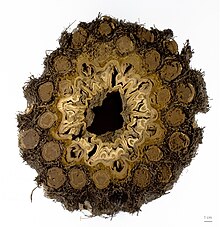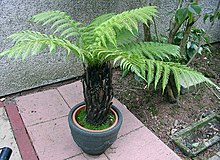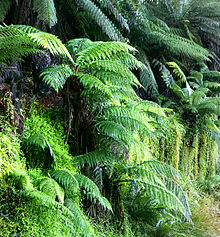
The tree ferns are arborescent (tree-like) ferns that grow with a trunk elevating the fronds above ground level, making them trees. Many extant tree ferns are members of the order Cyatheales, to which belong the families Cyatheaceae, Dicksoniaceae, Metaxyaceae, and Cibotiaceae. It is estimated that Cyatheales originated in the early Jurassic, and is the third group of ferns known to have given rise to tree-like forms. The others are the extinct Tempskya of uncertain position, and Osmundales where the extinct Guaireaceae and some members of Osmundaceae also grew into trees. In addition there were the Psaroniaceae and Tietea in the Marattiales, which is the sister group to most living ferns including Cyatheales.

This article relates to the flora of New Zealand, especially indigenous strains. New Zealand's geographical isolation has meant the country has developed a unique variety of native flora. However, human migration has led to the importation of many other plants as well as widespread damage to the indigenous flora, especially after the advent of European colonisation, due to the combined efforts of farmers and specialised societies dedicated to importing European plants & animals.

The order Cyatheales, which includes most tree ferns, is a taxonomic order of the fern class, Polypodiopsida. No clear morphological features characterize all of the Cyatheales, but DNA sequence data indicate the order is monophyletic. Some species in the Cyatheales have tree-like growth forms from a vertical rhizome, others have shorter or horizontal expanding rhizomes.

Platycerium is a genus of about 18 fern species in the polypod family, Polypodiaceae. Ferns in this genus are widely known as staghorn or elkhorn ferns due to their uniquely shaped fronds. This genus is epiphytic and is native to tropical and temperate areas of South America, Africa, Southeast Asia, Australia, and New Guinea.

Sphaeropteris cooperi, synonym Cyathea cooperi, also known as lacy tree fern, scaly tree fern, or Cooper's tree fern, is a tree fern native to Australia, in New South Wales and Queensland.
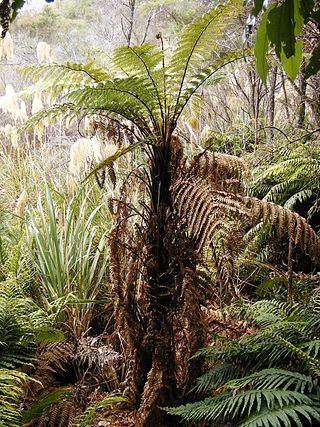
Dicksonia squarrosa, the New Zealand tree fern, whekī or rough tree fern, is a common tree fern endemic to New Zealand. It has a slender black trunk that is usually surrounded by many dead brown fronds.

Sphaeropteris medullaris, synonym Cyathea medullaris, commonly known as mamaku or black tree fern, is a large tree fern up to 20 m tall. It is distributed across the south-west Pacific from Fiji to Pitcairn Island. Its other Māori names include katātā, kōrau, or pītau.

Alsophila australis, synonym Cyathea australis, also known as the rough tree fern, is a species of tree fern native to southeastern Queensland, New South Wales and southern Victoria in Australia, as well as Tasmania and Norfolk Island.
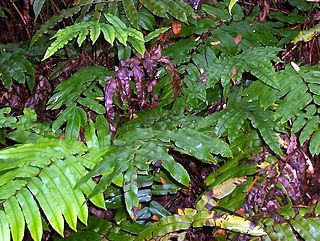
Parablechnum wattsii, synonym Blechnum wattsii, is a common terrestrial fern growing in rainforest and open forest. It is often seen near creeks in much of south eastern Australia, including Victoria, Tasmania, South Australia, New South Wales and Queensland. The specific epithet wattsii honours William Walter Watts (1856-1920). Watts was considered an authority on mosses and ferns and has more than 30 species named for him. Common names by which the species may be called are hard water fern - from its stiff leathery fronds, leech fern - as forest workers often encounter leaches while working in clusters of these ferns, hard hill fern - from the fern's habit and habitat, and red cabbage fern - from the bronze-pink colour of the young fronds resembling cooked red cabbage.
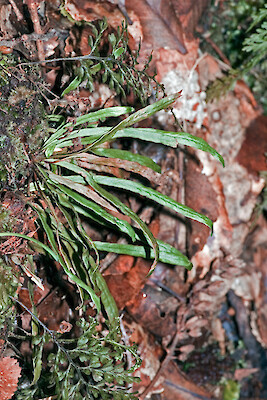
Notogrammitis billardierei, also known as the common finger-fern, or common strap fern, is a small epiphytic or lithophytic fern [1] with small, strap like fronds, found commonly in wet forest in South-Eastern Australia and New Zealand.

Polystichum proliferum, commonly known as mother shield fern is an Australian endemic fern. The genus name Polystichum is derived from Greek poly - many, and stichos - rows referring to the many rows of sori. The species name is derived from Latin, Proli – offspring and fer - bearing referring to the proliferous buds, a prominent feature of the species.
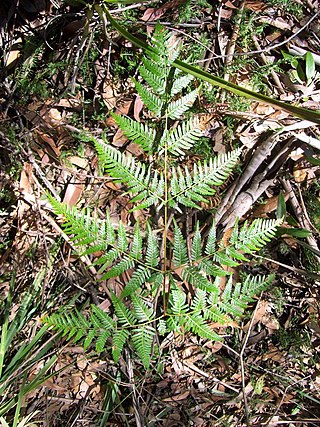
Pteridium esculentum, commonly known as bracken fern, Austral bracken or simply bracken, is a species of the bracken genus native to a number of countries in the Southern Hemisphere. Esculentum means edible. First described as Pteris esculenta by German botanist Georg Forster in 1786, it gained its current binomial name in 1908. The Eora people of the Sydney region knew it as gurgi.

Angiopteris evecta, commonly known as the king fern, giant fern, elephant fern, oriental vessel fern, Madagascar tree fern, or mule's Foot fern, is a very large rainforest fern in the family Marattiaceae native to most parts of Southeast Asia and Oceania. It has a history dating back about 300 million years, and is believed to have the longest fronds of any fern in the world.

Histiopteris incisa, the bat's wing fern, water fern or fern mata, is a common plant found in Australia, New Zealand and other islands in the south Pacific region. Usually found in moist areas, where it may form large colonies. The lowermost lobes of each pinnae have a bat wing like appearance, giving the fern its common name.

Pittosporum bicolor, commonly known as cheesewood or banyalla, is a flowering shrub or small tree of the family Pittosporaceae, and is native to south eastern Australia.
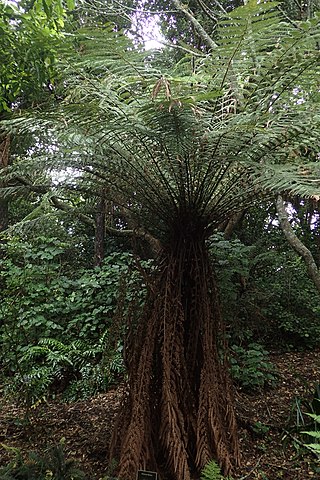
Dicksonia fibrosa, the golden tree fern, whekī-ponga or kuripaka is a species of medium-sized tree fern native to New Zealand.
Tasmania is home to 'Australia’s largest cool temperate rainforests. Most of Tasmania’s rainforests occur in the North-West and throughout the North East highlands. Cool temperate rainforests typically have a heavy rainfall, cool climate, favor high altitudes and have a limited availability of light.
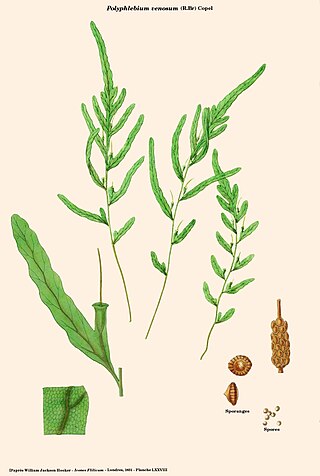
Polyphlebium venosum, the veined bristle-fern or bristle filmy fern, is a fern in the family Hymenophyllaceae. It is only found in wet forests, mainly growing as an epiphyte on the shady side of the soft tree fern, Dicksonia antartica. It also grows on logs, trunks of trees and rarely on trunks of Cyathea species or on wet rock-faces. It is found in the wetter parts of Eastern Australia and New Zealand. P. venosum has poor long-distance dispersal compared to other ferns due to its short lived spore. Notable features of Polyphlebium venosum include it being one cell layer thick, 5–15 cm in length, having many branching veins and a trumpet shaped indusium.
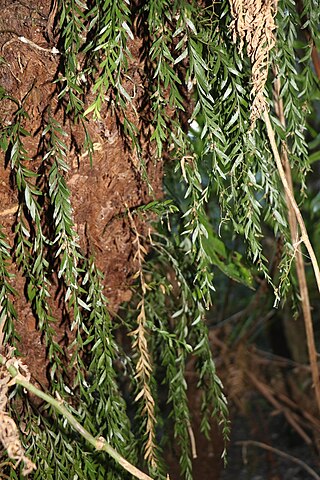
Tmesipteris obliqua, more commonly known as the long fork-fern or common fork-fern, is a weeping, epiphytic fern ally with narrow unbranched leafy stems. T. obliqua is a member of the genus Tmesipteris, commonly known as hanging fork-ferns. Tmesipteris is one of two genera in the order Psilotales, the other genus being Psilotum. T. obliqua is endemic to eastern Australia.

Hymenophyllum rarum, the narrow filmy-fern, is a species of fern from the family Hymenophyllaceae. This thin-leaved fern is commonly found in New Zealand and Tasmania, growing in patches on rocks and is epiphytic on trees and tree ferns, growing in moist gullies or rainforests. A rather drought tolerant species often found at exposed sites ranging from coastal to montane areas. Forming extensive, interwoven and creeping patches with its thin long (creeping) rhizomes sparsely covered in red-brown hairs, easily recognised by its membranous grey-green fronds, the smooth margins of the pinnae, ultimate segments and indusia; and by the sunken sori in the uppermost segments of the uppermost pinnae. The species can be found throughout Tasmanian rainforests as well as occurring in New South Wales, Victoria and New Zealand on the North and South Islands as well as, Stewart, Chatham and Auckland Islands.


